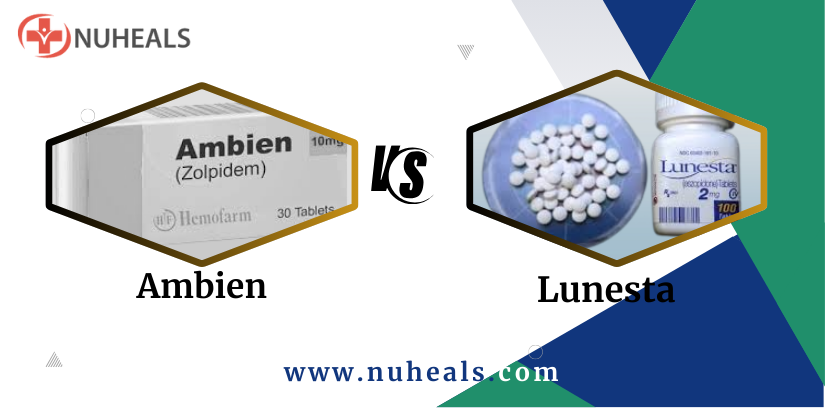Not everyone has sleeplessness. Prescribed drugs for insomnia are used by many of adults who struggle with falling and maintaining asleep. Ambien and Lunesta are the two primary drugs that pharmacists suggest, but there is significant dispute regarding their equivalency, safety when used combined, and dosages variances. We offer crucial information in this article, Ambien vs. Lunesta, to guide you in selecting a more effective insomnia drug for your body. Let us discuss.
A Comparative Analysis of Ambien vs Lunesta Differences
Overview of Ambien vs Lunesta?
Both Ambien and Lunesta are prescription drugs and also prescribed for adults to treat insomnia. These drugs belong to a specific class known as sedative-hypnotics, which act to slow down brain activity so that people can sleep.
Ambien is a common Prescription sedative medication that belongs to the hypnotic class of medication. It also has a brand name called Zolpidem. Ambien pills are used to treat insomnia temporarily. Also, it’s made to help people get to sleep faster and get more sleep overall. Ambien is a classified substance. It is categorized as a Schedule IV drug, ensuring that there is no risk that it will cause addiction or dependence. Ambien have a two different form for treatment of insomnia: Extended-release and Immediate-release capsule
Lunesta is a prescribed medicine and is generally used to treat Insomnia. Also, the brand name of Lunesta is Eszopiclone. It is a nonbenzodiazepine hypnotic drug and classified as a Schedule IV, which means that while misuse and dependency are not very possible, they are certainly allowed. Eszopiclone is an element of the sedative-hypnotic drug class and produces a relaxing effect on your brain.
Dosage Information
Ambien Dosage:
Ambien is available in Various types:
- For Immediate release (IR), the forms available are: AMB 5 mg and AMB 10 mg tablets
- There a 6.25 mg and 12.5 mg Ambien CR available.
Normal dosage:
- Women: 5 mg at bedtime (IR)
- Men: 5-10 mg (IR)
- In both women and men, Ambien CR starts with a dose of 6.25 mg
Lunesta Dosage:
Lunesta comes in:
Usual treatment:
- The first dose should be 1 mg before you go to bed
- If necessary, dosages of 2 mg and 3 mg are increased
Mechanism of Ambien And Lunesta
These medications have comparable ways of working due to belonging to the same class. Brain function by appears to be affected and calmed by gamma-aminobutyric acid (GABA), a substance that inhibits found in the brain’s nerve cells. By binding to GABA receptors, Ambien and Lunesta promote greater calmness and amplify all of its benefits, improving those who struggle with staying calm and falling asleep faster.
Differences Between Ambien Vs Lunesta
Considering both prescription drug work identically, Lunesta and Ambien have different ingredients. Ambien’s generic name is zolpidem, and Lunesta’s generic name is eszopiclone. Compared to Ambien, Lunesta usually persists longer. Lunesta has a 6-hour half-life will assist you in staying asleep over the night and provide lasting advantages. However, Ambien has a shorter half-life of 2 to 3 hours but helps you fall asleep more quickly. Some slightly differ in their doses; Ambien has an immediate release (Ambien IR) of 5 mg and 10mg, whereas an extended-release (Ambien CR) of 6.5mg and 12.5mg. In Contrast, Lunesta is available only in 1mg, 2mg, and 3mg.
Effectiveness of Ambien and Lunesta
According to clinical research, Ambien and Lunesta both work well in extending sleep duration, decreasing wakefulness, and improving sleep time. Both medications were more effective than some other sleeping pills. Ambien worked well, but harmed people more quickly. It was because of this that patients discontinued its use. They noted Lunesta brings short-term and long-term benefits, but brings side effects too.
According to your general health, the most helpful prescription is the one that performs best for you. A healthcare professional is able to guide you clinically on just what treatment course is the most effective.
Which is Better: Ambien Or Lunesta?
It can be difficult to decide between Ambien and Lunesta, Which is more effective for treating sleep problems. Lunesta could stay active extended than Ambien because of its prolonged half-life. Also, Lunesta can begin to have its full effects a little quicker than Ambien. However, some of the research suggests that Ambien may help you fall asleep more quickly. This is so if you take the recommended dosage. Lunesta for others and Ambien for certain people may work better. Consult with your doctor to become knowledgeable. That should help you find the right pick.
Side Effects
Understanding the possible side effects of Ambien and Lunesta is necessary when thinking about taking sleeping pills.
The following are frequent side effects of both medications:
- Feeling sleepy
- Lightheadedness
- A headache
- Feeling nervous
- chilly
- Having diarrhea
- Unusual dreams
The following are unique side effects that are nearly the same for both drugs:
- Irrationality
- Major depression
- Suicidal ideation and actions
- Perception
- Loss of memory
- Sleepwalking
- Memory issues
Conclusion
Ambien and Lunesta are similar medications that are used to treat insomnia. Lunesta is very effective for a longer duration in the system, and Ambien is helpful for fast-acting properties. They are suitable for particular circumstances, yet due to their remarkable distinctions. To prevent the side effects that may affect your safety and health, you must take them exactly as directed.





